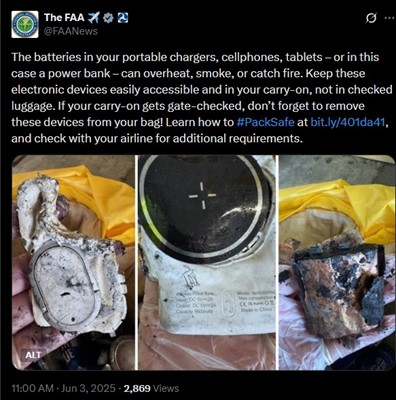The Summer Slice

As the summer skies heat up, so does the news. The Summer Slice is your weekly roundup of news and updates in the world of aviation, covering everything from tracking hurricane activity and managing the skies during peak travel times to improvements in air traffic control and reminders to pack safe. Whether you're in the sky or on the ground, the FAA's got you covered with the insights that matter most this summer.
Labor Day Weekend Travel Forecast
The FAA will see its busiest Labor Day holiday weekend in 15 years with nearly 323,000 flights between Wednesday, Aug. 27, and Tuesday, Sep. 2. While summer is winding down, we are still averaging nearly 50,000 flights a day. Thank you to all FAA employees and other stakeholders who keep flights moving safely and efficiently during the summer and all year round!
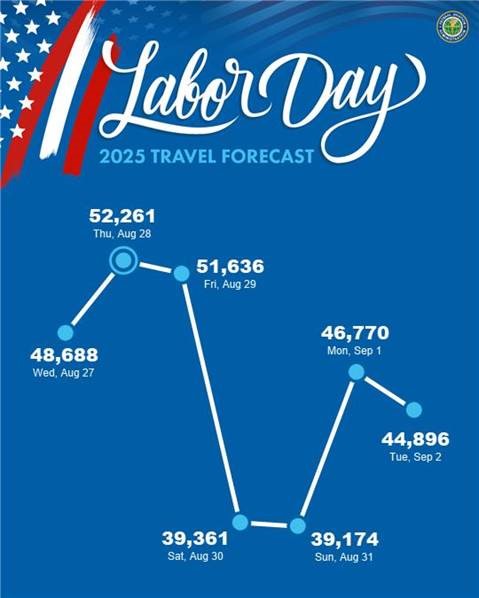
Readout from FAA Administrator Bryan Bedford’s Visit to Philadelphia and Newark
FAA Administrator Bryan Bedford visited Philadelphia International Airport and the FAA’s William J. Hughes Technical Center for Advanced Aerospace in New Jersey on Tuesday, Aug. 26.
Administrator Bedford toured the Philadelphia Terminal Radar Approach Control (TRACON) and air traffic control tower, where he met with air traffic staff. He also observed operations in both the TRACON and tower.
The administrator then participated in a ribbon-cutting ceremony for the new Engineered Materials Arrestor System (EMAS) at Philadelphia International Airport. EMAS is designed to stop an aircraft that overshoots the runway by using crushable material installed in the overrun area.
“EMAS is one more tool that helps us keep travelers, crews and aircraft safe. This technology has already proven to save lives by stopping more than 20 overrunning aircraft at airports,” said FAA Administrator Bryan Bedford.
There are 118 EMAS systems at more than 60 U.S. airports.
Administrator Bedford also visited the FAA Technical Center in New Jersey where he saw demonstrations of advanced research programs, including the Remote Tower Test Bed, the National Airport Pavement Test Facility, the Fire Safety Test Facility, and the NAS Innovation and Emerging Concepts Lab. Administrator Bedford thanked FAA employees and researchers for their dedication to advancing safety, efficiency and innovation in the National Airspace System.
On Wednesday the administrator visited the air traffic control tower at Newark Liberty
International Airport in New Jersey where he again met with air traffic staff and observed
operations.
Download B-Roll from Tuesday’s visits.
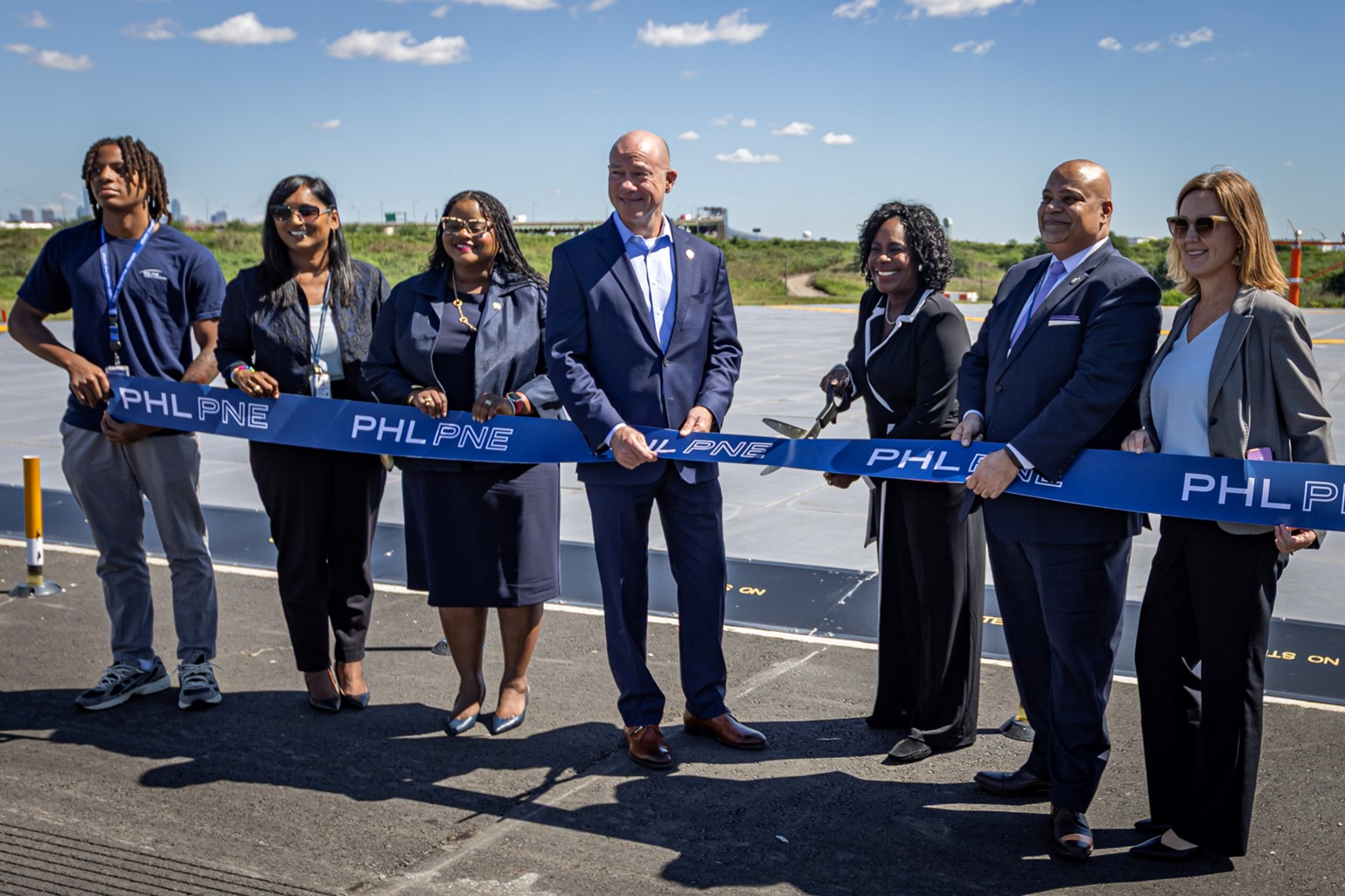
FAA Weather Squad Guest Forecaster
This week’s guest Weather Squad forecaster is CBS meteorologist Rob Marciano. Rob brings us the rest of this week’s weather, including cooler temperatures in the East, monsoons in Arizona and a relatively quiet Labor Day weekend.
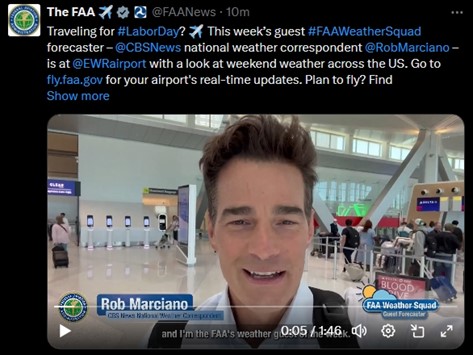
Busy Summer
In a surprising late-summer grab for attention, we saw nearly 55,000 flights last Thursday, Aug. 14. This was the third busiest day of the year and takes the number four spot for our busiest day since 2011. We’ve seen more than five million flights since Memorial Day weekend, making it the busiest summer in 15 years.
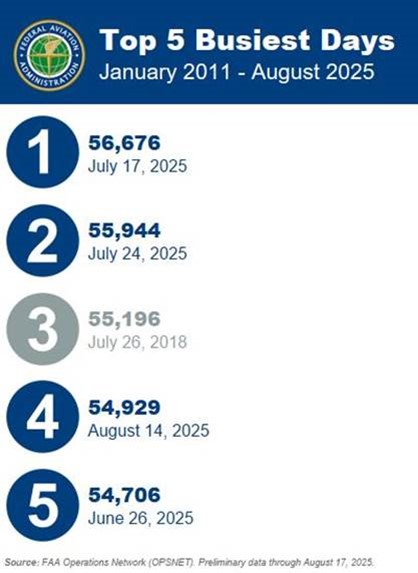
National Aviation Day
The FAA and the National Air and Space Museum celebrated National Aviation Day on Tuesday by recognizing incredible aviation milestones. Groundbreaking moments like the Wright Brothers’ first powered flight at Kitty Hawk in 1903, the establishment of airmail routes, and the development of supersonic flight have shaped American aviation.
FAA Weather Squad Guest Forecaster
Our guest Weather Squad forecaster of the week is Chris Dunn, also known as The Flying Weatherman, with 12 News in Phoenix. Along with being an award-winning meteorologist, Chris is also a certified commercial pilot and flight instructor. Chris discusses lingering high temperatures in Phoenix and Las Vegas, thunderstorms along the East Coast, and how travelers can best avoid flight disruptions during the summer months.
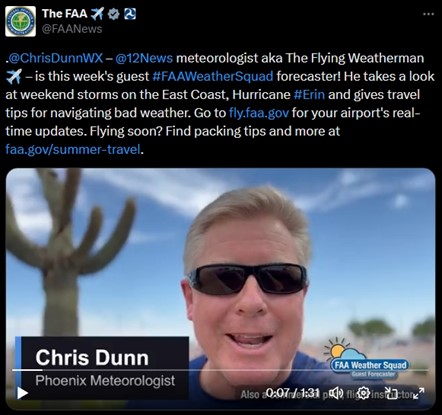
ICYMI
- As hurricane season nears its most active period, learn more about how the FAA prepares and responds to natural disasters by reading our latest blog.
- The FAA has officially licensed 1,000 space operations! We’re excited to be at the forefront of this rapidly growing sector.
Nashua Community College Joins Enhanced AT-CTI
Nashua Community College in New Hampshire is the latest school to join the Enhanced Air Traffic – Collegiate Training Initiative program (Enhanced AT-CTI). This program is one of the ways the FAA is bolstering our controller workforce. Nashua Community College is the first school in New Hampshire to adopt the Enhanced AT-CTI program.
A New ATC Pipeline
The FAA signed our first Control Tower Operator Partnership Program (CTO-P) agreement with Advanced ATC in Selma, Alabama. The first students graduated last week and are on their way to federal contract towers (FCTs) across the country. Graduates with 52 weeks of relevant air traffic control experience at an FCT are eligible for direct hire with the FAA, building another pipeline into our controller workforce.
Hazardous Materials Safety Inspectors
Hazardous materials aviation safety inspectors make sure that hazardous materials are shipped safely. They help keep dangerous items like lithium batteries, flammable materials or aerosol cans out of luggage. Learn more about their work by reading our latest Cleared for Takeoff blog.

FAA’s Travel Weather Courtesy of KSAT
This week’s FAA Weather Squad guest forecaster is Adam Caskey with KSAT in San Antonio. He brings us the rest of the week’s weather, which includes a dry western half of the country, a rainy eastern half, and high temperatures sweeping eastward over the weekend.
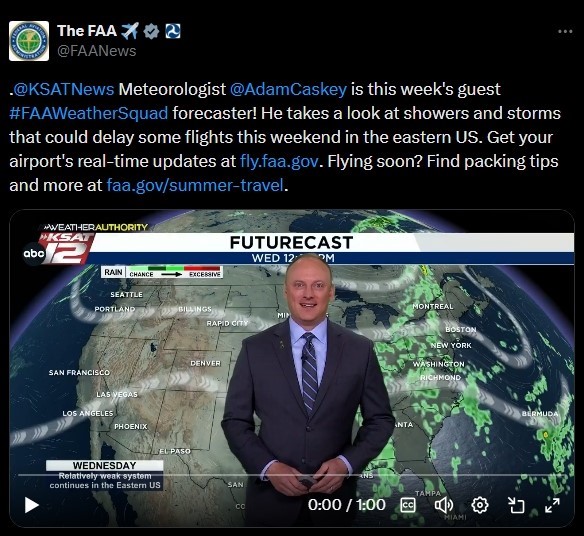
ICYMI
- This past weekend, U.S. Transportation Secretary Sean P. Duffy and the FAA’s Acting Air Traffic Organization Chief Operating Officer Frank McIntosh visited one of the nation’s oldest air traffic control towers. Duluth International Airport in Minnesota has the third-oldest operating FAA tower in the country. It was an opportunity to showcase why $12.5 billion in the One Big Beautiful Bill will be dedicated to getting started on a new state-of-the-art air traffic control system.
- Secretary Duffy and FAA Administrator Bryan Bedford visited Alaska this week to show our dedication to improving aviation safety in the state. With the President’s One Big Beautiful Bill, we will invest in getting Alaska the upgrades it needs.
- Last week, the FAA proposed to extend the limited rate of arrivals and departures into and out of Newark Liberty International Airport through Oct. 24, 2026. This aims to maintain safety while easing delays for the traveling public.
Hiring for N90
The FAA is looking for the best and brightest to take on the challenge of working at New York Terminal Radar Approach Control (N90), controlling air traffic in one of the busiest airspaces in the country. New hires will take a specialized training program, along with the normal curriculum at the FAA Academy in Oklahoma City, designed specifically for the New York airspace. The window to submit applications is Aug. 8 – 15, and new hires will be at the Academy by November. You can learn more at our webpage dedicated to N90 hiring.
BVLOS Drone Dominance
U.S Transportation Secretary Sean P. Duffy announced a proposed rule to make Beyond Visual Line of Sight (BVLOS) drone operations safe, routine and scalable. Normalizing BVLOS flights is key to realizing drones’ societal and economic benefits. Package delivery, agriculture, aerial surveying, public safety, recreation, and flight testing are just some of the uses we expect to see.
FAA Drone Detection Testing
The FAA will conduct drone-detection testing at Camp Grafton, North Dakota, from Aug. 11-22. The FAA’s Center of Excellence for UAS Research (ASSURE) will conduct the testing in coordination with state and local law enforcement. The agency has conducted testing in Alaska, New Jersey, and New Mexico. Additional testing is scheduled in Mississippi later this year. The FAA will operate several large drones and about 100 commercial off-the-shelf drones during the two-week period. The agency has been testing drone-detection technologies at airports over the last few years and is expanding testing to off-airport locations. These tests will help determine the effectiveness of these technologies and whether they might interfere with FAA or aircraft navigation systems.
Check out this video from the June drone-detection testing in New Mexico.
Guest Weather Squad Forecaster
The FAA’s guest weather squad forecaster last week was James Spann, WBMA Chief Meteorologist and founder of the Alabama Weather Network. This week we welcome Jessica Burch, CBS News Bay Area meteorologist and Black Hawk pilot for the Army National Guard. Jessica is highlighting the rest of this week’s weather, with some areas affected by smoke and hazy conditions and others seeing strong thunderstorms.
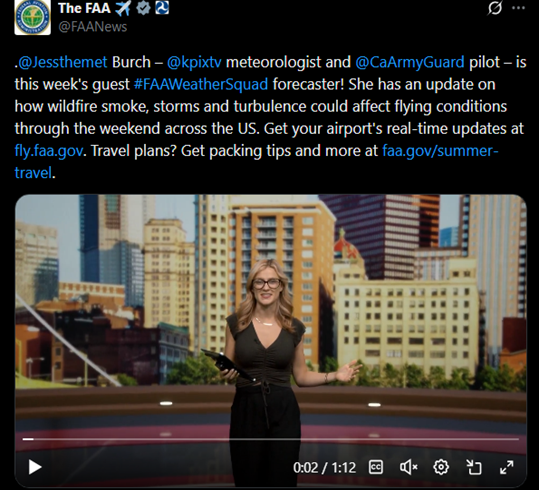
Traveling with Children
If you plan on flying with your little ones, be sure to buckle up your baby in an FAA-approved child safety seat. For more tips, visit our flying with children webpage.

Wildlife and Aviation
Wildlife strikes at airports across the country are decreasing thanks to the efforts of hundreds of on-site biologists working hard to keep travelers and wildlife separate and safe. Learn how the FAA addresses wildlife hazards around airports by reading our latest blog. You can search for strike data on our National Wildlife Strike Database.
ICYMI
- The FAA is dedicated to introducing more air traffic controllers into our workforce. We’ve created new pathways by announcing the Control Tower Operator Partnership (CTO-P). This program allows graduates of FAA-approved CTI programs to train and certify at Federal Contract Towers (FCTs). FCTs are staffed by employees of private companies while still adhering to FAA safety standards. Once fully certified for 52 weeks at an FCT, controllers are eligible for direct hire into the FAA.
- AirVenture at Oshkosh brings something new every year and highlights exciting advancements in aviation. This year’s Oshkosh was a jam-packed week of safety forums, on-the-spot hiring and groundbreaking innovation at the world’s largest general aviation show. Thank you to all who participated and everyone who attended!
AirVenture at Oshkosh 2025
The largest general aviation air show in the world is taking place this week in Oshkosh, Wisconsin. EAA AirVenture at Oshkosh will host over 500,000 aviation enthusiasts. If you can’t make it there, you can follow the event’s live stream and the FAA’s social media.
Transportation Secretary Sean P. Duffy and FAA Deputy Administrator Chris Rocheleau visited the air traffic control tower at Oshkosh airport to see our air traffic controllers and technical operations specialists in action. These dedicated employees undergo specialized training to prepare for this major event.
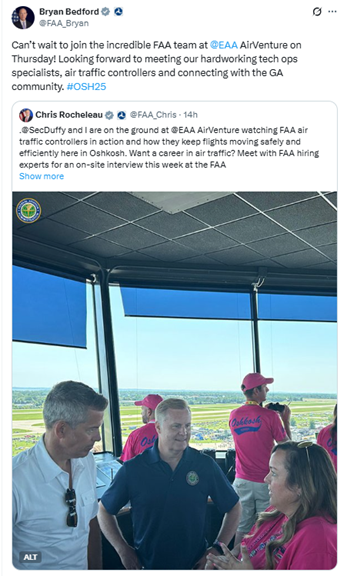
MOSAIC
On Tuesday at AirVenture, U.S. Transportation Secretary Sean P. Duffy announced a new FAA rule to improve recreational aviation safety, expand pilot privileges, and support technological innovation while reducing regulatory burdens. The Modernization of Special Airworthiness Certification (MOSAIC) final rule makes sweeping changes to the Light Sport Aircraft (LSA) category and to Sport Pilot privileges, expanding a safe alternative to experimental amateur-built aircraft. Read more about the final rule.
Busiest Day of the Year
Thursday, July 17 was the busiest flight day the FAA has seen in 15 years! Thank you to all FAA employees for ensuring air travel moves safely and efficiently across the country.
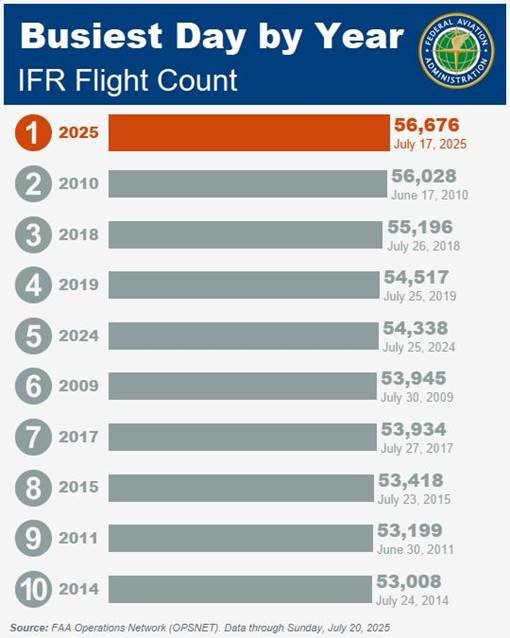
Guest Weather Squad Forecaster
This week’s Weather Squad guest forecaster is the FAA’s own Frank McIntosh, acting Air Traffic Organization Chief Operating Officer. Frank gives us the country’s weather forecast for the next few days from Oshkosh.
Busy Summer
With just over 54,200 flights, Thursday, July 10 was the second busiest day so far this year. Flight counts are expected to continue to climb as the summer goes on. Learn how the FAA keeps flights moving safely and efficiently this summer.
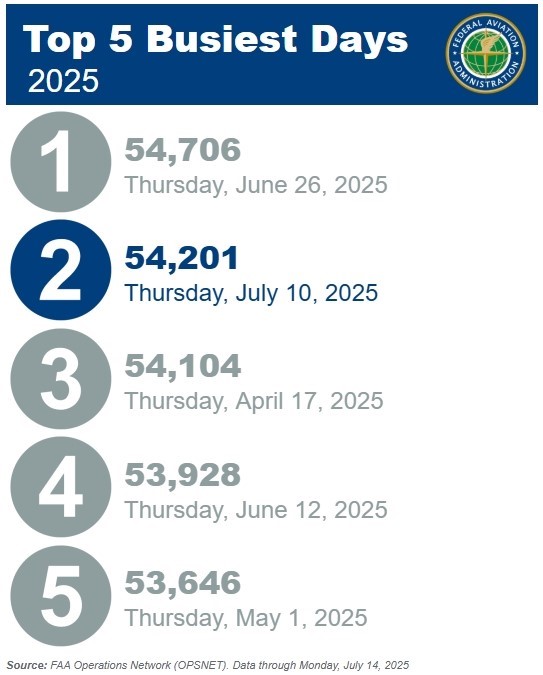
Guest Weather Squad Forecaster
The FAA guest Weather Squad forecaster this week is CBS Chief Weathercaster and pilot Lonnie Quinn. Lonnie is highlighting areas of extreme heat and high winds as well as a tropical system forming in the Gulf that may impact flights across the U.S.
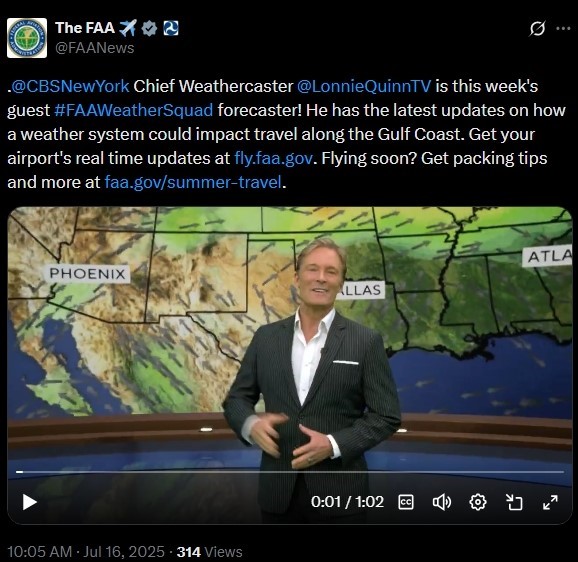
Traveling with Children
The FAA has tips if you plan on flying with kids this summer. Make sure your little one is prepared to travel and knows what to expect.

FAA Welcomes New Administrator Bryan Bedford
Bryan Bedford was sworn in this week as the FAA’s new Administrator. He brings more than 35 years of aviation experience to the FAA, including 26 years as CEO of Republic Airways. He will immediately begin visiting FAA facilities nationwide to meet employees, hear their perspectives, and better understand the challenges and opportunities ahead.

National Air Traffic Control Week
National Air Traffic Control Day was on Sunday, July 6. Here at the FAA, we want to shine the spotlight on our air traffic controllers all week. Thank you to the men and women who work hard every day to keep our skies safe and moving efficiently!
We’re giving you a behind the scenes look at air traffic controller training at the Academy in Oklahoma City. See photos of the rigorous training students go through, from tabletop exercises to training simulations where students experience real conditions they may see in the field.
The Academy tests an individual’s aptitude for the job. After passing the initial qualifications they go on to receive years of air traffic controller training before fully certifying. We’re hiring the best and brightest, and that means thinking fast, thinking several steps ahead and being able to visualize a scenario. Air traffic control is a high-pressure job; our candidates should be able to display their ability to work under any condition. See how they handle it all.

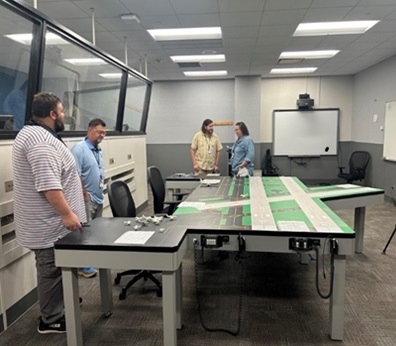
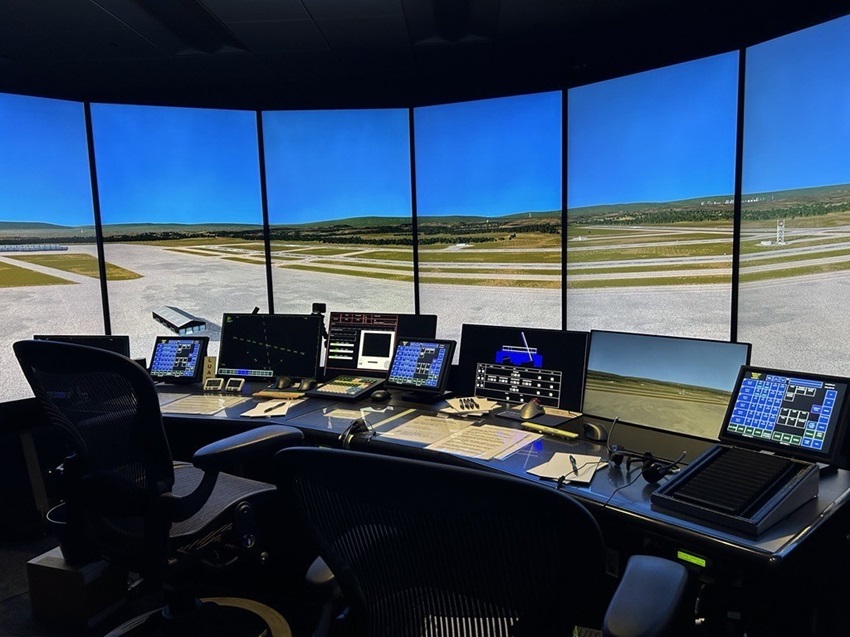
Lithium Battery Fire
Flight attendants put out a lithium battery fire after a passenger on Delta Air Lines Flight 1334 spotted smoke coming out of the backpack stowed under the seat in front of him. The cabin crew doused the power bank that was on fire and put it in a fire containment bag. The flight landed safely at Southwest Florida International Airport on July 7. Remember to never put anything with a lithium battery in checked luggage. Always #PackSafe, keep batteries with you in the cabin and if you see smoke, call a flight attendant for help.
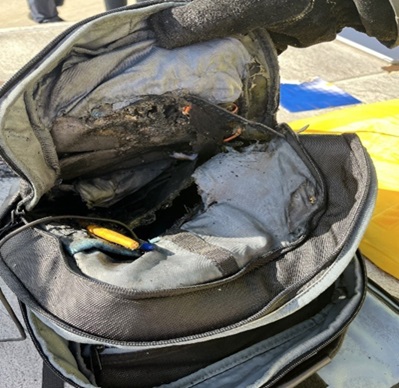
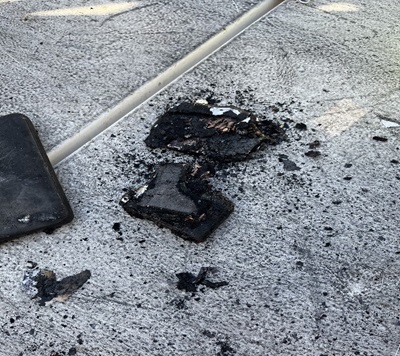
Guest Weather Squad Forecaster
This week’s guest Weather Squad forecaster is storm chaser Vince Waelti. Vince live streams tornadoes, blizzards and hurricanes on his YouTube channel.
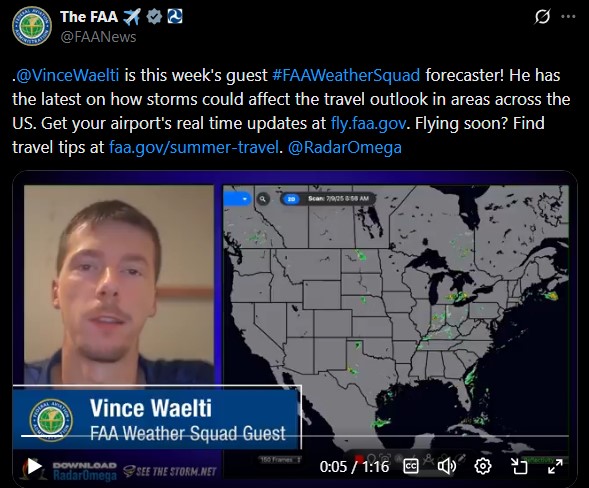
ICYMI
The FAA has taken the next steps to improve operations at Newark Liberty Airport. New fiber lines will improve network infrastructure and reliability for travelers.
Busy Summer Travel Underway
This week marks the busiest Fourth of July travel period in 15 years, with July 3 expected to be the busiest day. And this just in: with almost 55,000 flights, last Thursday, June 26, claimed the spot as our busiest day so far in 2025! We expect travel numbers to build through the end of July.
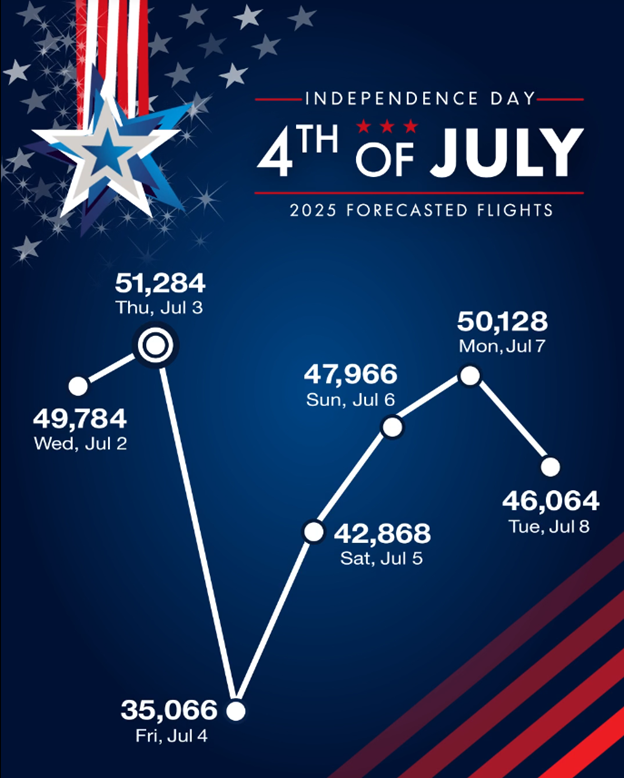
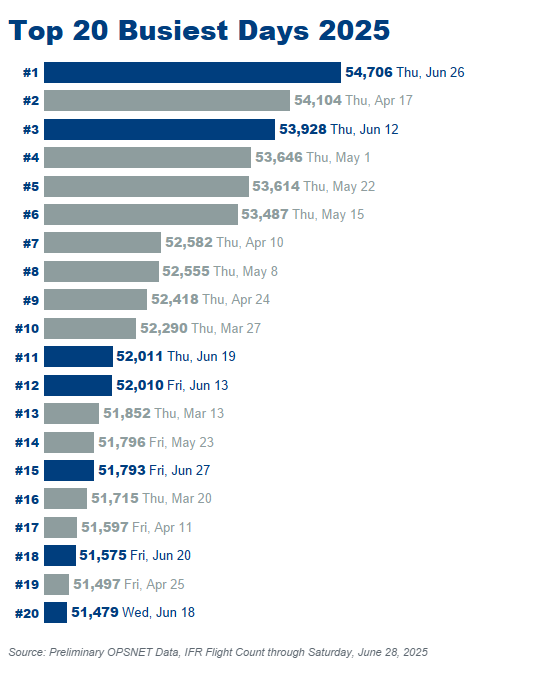
Guest Weather Squad Forecaster
This week’s guest Weather Squad forecaster is Veronica Johnson, chief meteorologist with 7News in Washington, D.C. Veronica is highlighting the nation’s weather for today and the July Fourth holiday. Watch her video along with our daily Weather Squad videos on X.
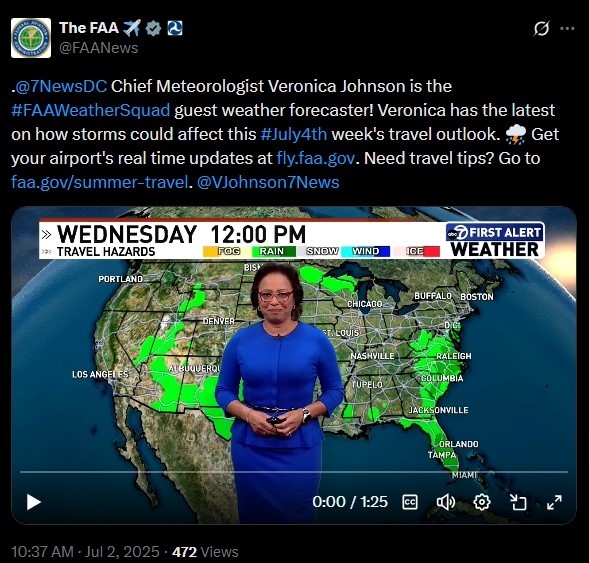
Acting Administrator Chris Rocheleau on Advanced Air Mobility
The FAA is pushing forward to safely integrate advanced air mobility (AAM) aircraft into our airspace. The FAA is working with the UK, Canada, New Zealand and Australia to align AAM standards, share data, and streamline certification and validation processes.

Middle Georgia State University Joins Enhanced AT-CTI
The FAA signed an agreement with Middle Georgia State University to become the next school in the Enhanced Air Traffic – Collegiate Training Program (Enhanced AT-CTI). This program allows students to train and get to air traffic facilities faster. Middle Georgia State University is the first school in Georgia to adopt the program.
Turbulent Behavior
The FAA has a zero-tolerance policy for unruly passengers. Everyone has somewhere to be this summer; remember to keep your cool, even as temperatures rise. Unruly passengers can face fines, travel restrictions or even jail time.
ICYMI
June saw 21 licensed commercial space launches—the most ever in a single month! The FAA is responsible for the safe and efficient integration of space operations into the National Airspace System. As the amount of space launches and reentries increases, the FAA works hard to reduce impacts, increase safety and respond quickly to any mission anomalies.
Laser strikes can temporarily blind pilots and place passengers in harm’s way. This Fourth of July, ensure your lasers aren’t endangering any aircraft.
Fourth of July Flight Forecast
The FAA is preparing for the busiest Fourth of July week we’ve seen in 15 years! We are anticipating a total of more than 300,000 flights throughout the week. Be sure to pack safe if you’re flying for the holiday, and remember, fireworks don’t fly.

FAA Weather Squad
The FAA’s Weather Squad posts a daily video on X highlighting weather conditions across the national airspace that could affect flight operations. Our Weather Squad is comprised of Air Traffic Watch Officers from the Joint Air Traffic Operations Center, meteorologists from our National Weather Service unit, and other FAA personnel.
This summer, we are welcoming a guest Weather Squad star once a week starting today! This week’s guest is Meteorologist Nick Kosir from Fox Weather, also known as The Dancing Weatherman. He’s here to give us the rest of the week’s weather and how it might affect flights across the U.S.
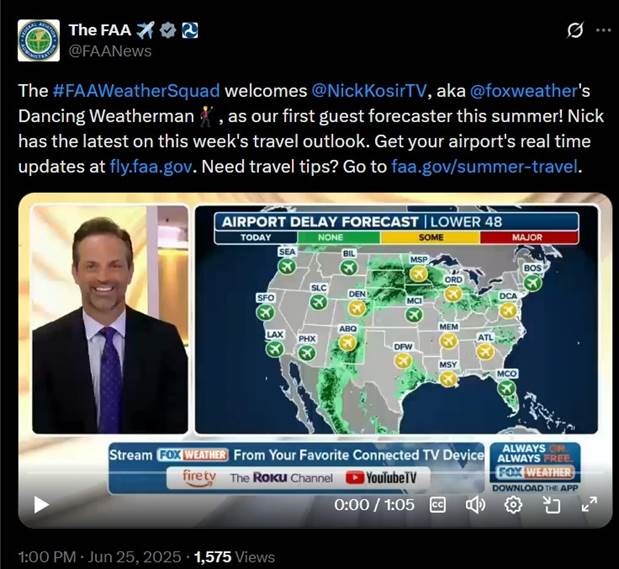
New Mexico Drone Testing Footage
The FAA is conducting drone detection testing near Santa Teresa, New Mexico, through June 27. Watch our video of the New Mexico testing.
In Case You Missed It
- The NTSB this week released its probable cause determination for the Jan. 5, 2024, Alaska Airlines door plug accident. The NTSB also issued 10 recommendations to the FAA. The FAA takes NTSB recommendations seriously and will carefully evaluate them. Our response and detailed information about our enhanced Boeing oversight is on the FAA website.
- Owning a drone can be fun, but make sure you learn the rules of the sky before taking off. See our latest drone post on X to learn more.
Transportation Secretary Sean P. Duffy and Acting FAA Administrator Chris Rocheleau announced from the Paris Air Show that the FAA and aviation authorities from Australia, Canada, New Zealand and the United Kingdom are collaborating on an Advanced Air Mobility roadmap to ensure the safe rollout of eVTOLs. The roadmap will foster collaboration, promote innovation and streamline the certification and validation process for new aircraft types.

Capping and Tunneling
Air traffic controllers use a variety of strategies to get travelers to their destinations safely, including something we call “capping and tunneling.” Capping limits an aircraft’s altitude to avoid poor weather conditions or congested airspace while tunneling uses corridors to bypass congested areas. These strategies enhance safety and efficiency across U.S. airspace. Watch our video explaining how capping and tunneling works.
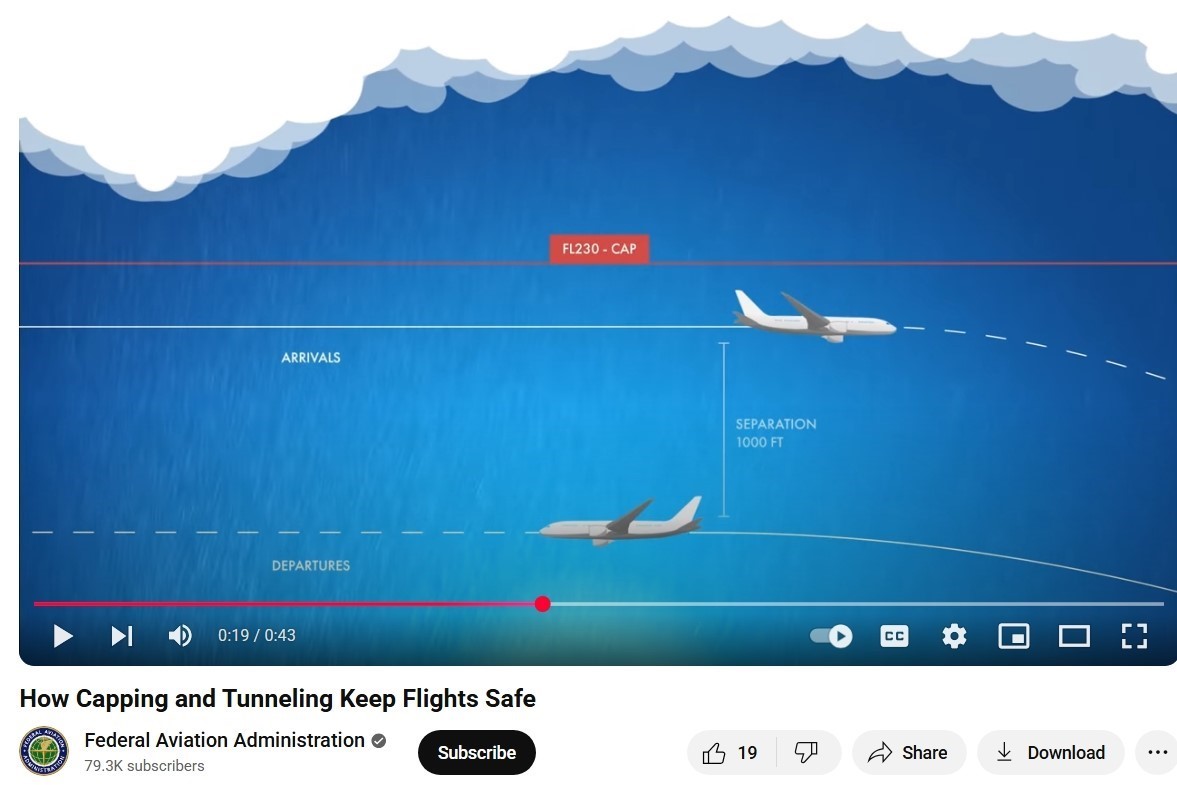
For Travelers – fly.faa.gov
Need airport information before you fly? Be sure to visit fly.faa.gov and reach out to your airline. Traveling with electronics? Pack lithium batteries in your carry-on luggage and keep them near you onboard the aircraft. Lithium batteries can overheat and spark an on-board fire. Immediately notify flight crew if your battery or device is overheating.
In Case You Missed It
- The FAA is conducting drone detection testing near Santa Teresa, New Mexico, through June 27. This is the third in a series of off-airport testing, the first taking place in Alaska and the second in Cape May, New Jersey. The FAA selected the New Mexico location for its hot and arid climate. Next up is North Dakota and Mississippi later this year. These tests will help determine the effectiveness of these technologies and whether they might interfere with FAA or aircraft navigation systems.
- The FAA recently published modifications to the helicopter zones and routes around Ronald Reagan Washington National Airport (DCA). We continue to assess safety data and areas of risk at airports with high volumes of mixed traffic.
- Be sure to watch our latest From the Flight Deck video alerting pilots and operators to a runway incursion risk on the north LAX airfield.
Surface Safety Spotlight – Los Angeles International Airport (LAX)
Los Angeles International Airport (LAX) is one of the nation’s busiest commercial airports. This short video highlights a runway incursion hazard where pilots exiting Runway 24R, particularly via taxiways V and W, may inadvertently cross the Runway 24L hold-short line. There is no center taxiway between parallel runways 24R and 24L, and the runways are closer than pilots may expect. In addition, pilots must ensure that they fully clear Runway 24R when exiting. The FAA created this video outlining recent taxiway changes to help pilots mitigate this hazard.
Army’s 250th Anniversary Celebration
The Army’s 250th anniversary celebration is this weekend in Washington, D.C. and will include a flyover and fireworks on Saturday, June 14. The celebration will impact operations at Ronald Reagan Washington National Airport (DCA). To ensure safety and security during the celebration, the FAA will issue Temporary Flight Restrictions (TFRs) for the Washington, D.C., area. The FAA will also implement traffic management initiatives (TMI) at DCA before, during, and after the event. These TMIs will stop all arrivals and departures at DCA during the peak of the celebration. Travelers are urged to check with their airline and visit fly.faa.gov for the latest updates.
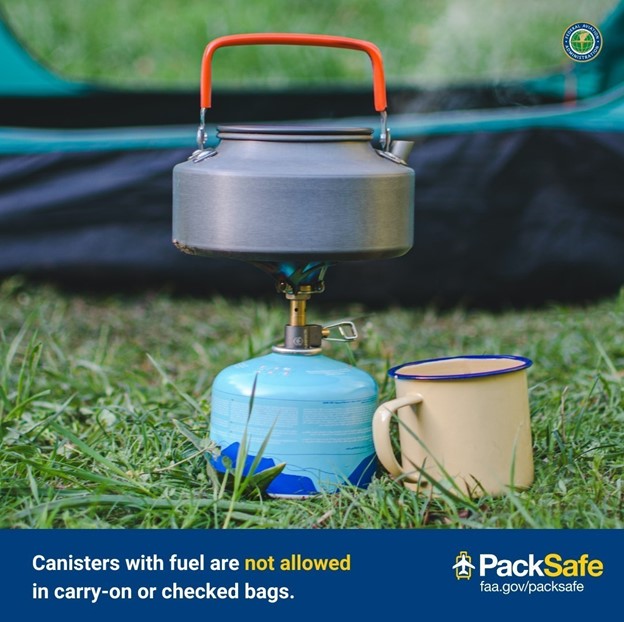 For Passengers – Camping
For Passengers – Camping
If you’re traveling by airplane to your camping destination, it’s important to know what’s allowed and prohibited in your bag.
- Camp stove purged of fuel – ✅
- Bear spray aerosol –🚫
- Headlamp spare lithium batteries ✅ carry-on bag only
Know before you go! Visit faa.gov/packsafe and NPS.gov to plan your trip and prepare for a safe adventure.
In Case You Missed It
Building the Air Traffic System of the Future
U.S. Transportation Secretary Sean P. Duffy and the FAA are calling on world-class innovators to help build a new, state-of-the-art air traffic control system. We’re seeking an integrator to manage this effort, including acquiring capabilities, and deploying the new technologies. As a first step, the FAA is seeking information about how best to implement this new air traffic system. This bold effort will shape the future of American Aviation. Interested companies can learn more about this plan by attending our Industry Days June 10-12.
Newark Updates
U.S. Transportation Secretary Sean P. Duffy announced on June 2 that construction on Runway 4-Left/22-Right at Newark Liberty International Airport was completed 13 days ahead of schedule. The runway is open only for departures until the FAA finishes flight checks to ensure landing aids are operational and the runway is safe for arrivals. The airport will continue to operate with a maximum arrival rate of 28 aircraft an hour until those checks are complete. After that, the airport’s maximum arrival rate will be 34 aircraft an hour. It should be fully operational for both departures and arrivals the week of June 9.
Hurricanes
This week marks the start of hurricane season, which officially began June 1 and ends November 30. The National Oceanic and Atmospheric Administration (NOAA) forecasts between 13 and 19 named storms for 2025, which means now is a good time to learn more about how to prepare.
June 1 and ends November 30. The National Oceanic and Atmospheric Administration (NOAA) forecasts between 13 and 19 named storms for 2025, which means now is a good time to learn more about how to prepare.
Hurricanes typically start out as a low-pressure system that moves through the warm ocean waters of the tropics. The warm water fuels rain and thunderstorm activity, allowing the system unlimited access to the power it needs to organize and develop. The tropical wave becomes a tropical storm when sustained wind speeds reach 39 miles per hour. At this stage, the storm is given its predetermined name. This year’s storm name list begins with Andrea and ends with Wendy. Once wind speeds within the storm reach 74 miles per hour, the system is officially a Category One hurricane. On a scale of one through five, hurricanes are rated based on maximum sustained windspeeds. Hurricanes are considered major when they reach category three status, with wind speeds between 111 and 129 miles per hour.
Hurricane Hunters
While the FAA prepares all year for natural disasters,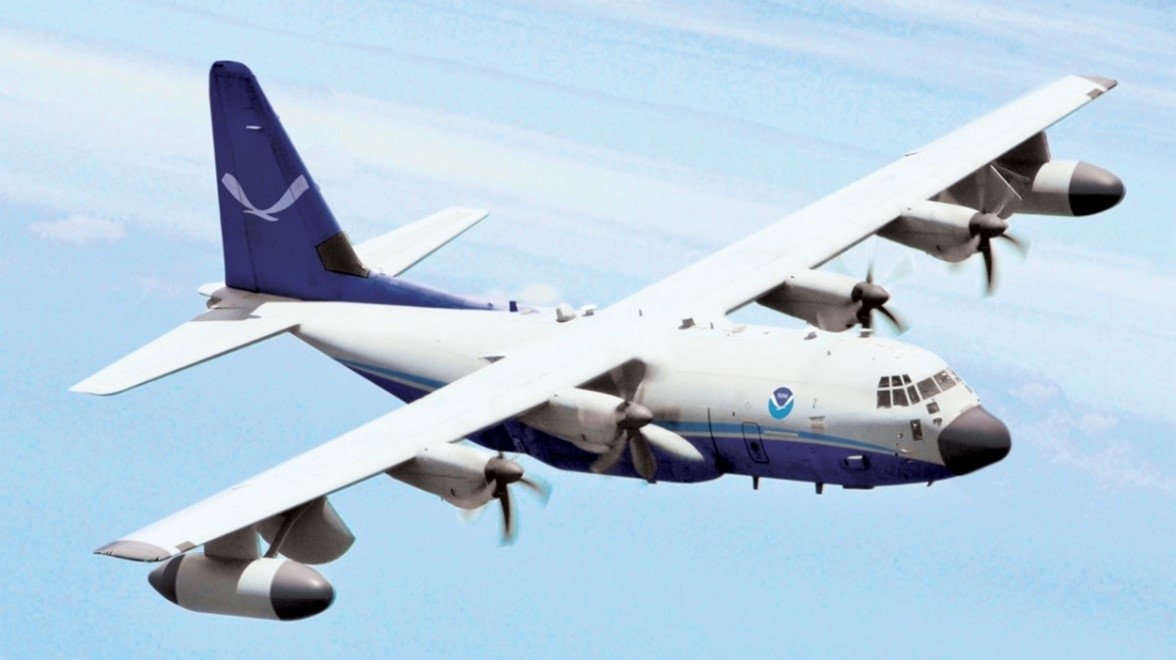 researchers at NOAA spring into action as soon as a hurricane forms. Hurricane Hunters fly directly into the storms to gather critical data that can improve forecasts and help the public prepare. NOAA has two Lockheed P-3 Orions to handle this task, one named “Kermit” and one named “Miss Piggy.” Scientists aboard the aircraft use instruments to measure pressure, humidity, temperature, wind direction and wind speed. The Hurricane Hunters’ wind-speed measurements are often how hurricanes are upgraded or downgraded in category.
researchers at NOAA spring into action as soon as a hurricane forms. Hurricane Hunters fly directly into the storms to gather critical data that can improve forecasts and help the public prepare. NOAA has two Lockheed P-3 Orions to handle this task, one named “Kermit” and one named “Miss Piggy.” Scientists aboard the aircraft use instruments to measure pressure, humidity, temperature, wind direction and wind speed. The Hurricane Hunters’ wind-speed measurements are often how hurricanes are upgraded or downgraded in category.
The FAA is Prepared
When storms arise, the FAA is ready. We use a variety of strategies to get travelers to their destinations safely. NOAA provides critical forecast data that helps the FAA prepare for any impacts weather may have on our operations. Our highly trained air traffic controllers work around the clock, in different types of facilities, to orchestrate the safe and efficient movement of thousands of flights each day. We also created new ultra-high sectors at the Jacksonville Air Route Traffic Control Center that reduce delays by accommodating more aircraft.
For Passengers
It’s important to keep portable chargers, cellphones and tablets with you and easily accessible in carry-on bags. See our latest post on battery safety, showing what can happen when battery banks overheat. Monitor the status of any commercial airport across the National Airspace System at fly.faa.gov. Follow the FAA on X for timely updates and Weather Squad videos straight from the JATOC. These five tips can help travelers reach their destinations safely and smoothly.
In Case You Missed It
Flight Attendant Appreciation Day was Saturday, May 31. See our post on X recognizing Ellen Church, one of the first flight attendants. As aviation’s first responders, flight attendants are highly trained in emergency response and ensure the safety of passengers. Thank you to all flight attendants!
The FAA kicked off what we expect will be our busiest summer in 15 years this past Memorial Day weekend. We saw almost 54,000 flights last Thursday and those numbers will keep climbing throughout the summer. Cancellations over the weekend were less than one percent and delays were less than three percent. Nearly 60 percent of those delays were due to weather. While most of the country is starting to get their first taste of summer, we at the FAA have been preparing for months to handle the increase in travel.
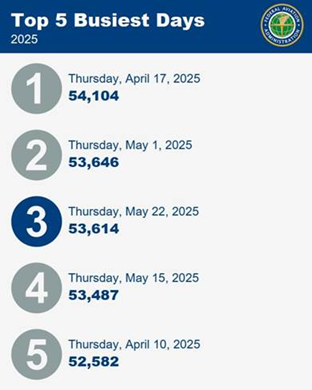
Joint Air Traffic Operations Center (JATOC)
The FAA’s Joint Air Traffic Operations Center works hard every day to ensure the safe and efficient flow of air traffic across the National Airspace System. When severe weather hits, the dedicated experts at the JATOC quickly plan routes around the storms and protect equipment and FAA personnel before, during, and after the event. Learn more about what the JATOC does to ensure the safety of air travel by watching our newest YouTube video.
Myth-Buster: Extreme Heat and Flying
Have you ever flown out of Phoenix or Las Vegas and experienced delays on a perfectly clear day? Travelers will sometimes joke that it’s so hot outside the airplane tires are melting. This is an urban legend; your aircraft’s tires are not melting. Instead, some simple science is getting in the way of your escape from the heat.
Because hot air is less dense than cold air, it’s harder for an aircraft’s wings to generate lift. The airplane can still fly, but it requires a longer takeoff roll to generate the lift it needs. While the FAA doesn’t cancel flights due to extreme heat, airlines and flight crews must follow guidelines that specify the maximum safe temperature for an aircraft to operate.
Your mid-afternoon flight is more likely to get delayed than an earlier flight because peak temperatures hit between 3 and 4:30 p.m., which coincides with one of the busiest times of day at airports. Your best bet is leaving early in the morning so those hot summer afternoons don’t disrupt your departure!
System Updates and Safety Messaging
Transportation Secretary Sean Duffy has announced his plan to update the air traffic control system. Acting FAA Administrator Chris Rocheleau wants the flying public to know that while our current air traffic system needs updating, air travel is still the safest form of transportation. If necessary, the FAA slows down air traffic to ensure safety within the National Airspace System. Learn more about how the FAA is handling the issues facing Newark.

For Passengers
Monitor the status of any commercial airport across the National Airspace System at fly.faa.gov. Follow the FAA on X for timely updates and Weather Squad videos straight from the JATOC. These five tips can help travelers reach their destinations safely and smoothly. See our latest post on battery safety.

